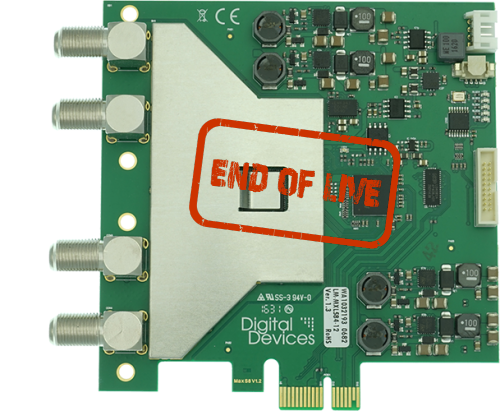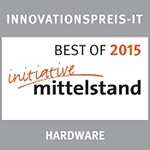8 DVB-S2 Tuner
- 4/8x DVB-S2 (SAT-Tuner)
HDTV – H.264/MPEG4
Support of many TV Applications
- Microsoft Windows® Media Center 7/8, DVBViewer, Media Portal, Gen2VDR, MythTV
Features
- QPSK up to 45 MSym with up to 120 MBit/s (required for UltraHD transponders)
- Sensitivity < 30 dBµV
DiSEeqC 2.0 Support
Unicable® SCR/Cenelec EN50494
- Supports up to 8 tuners with just one antenna cable using Unicable®/SCR/CENELEC EN50494 compliant LNB or multi switch.
JESS©/Cenelec EN50607
- Supports up to 32 tuners with just one antenna cable using CENELEC EN50607 compliant LNB or multi switch.
PCIexpress
- Connection via PCIe x1 up to x16 slot
GT-Link Port
- To connect to Octopus NET (Data rate > 1GBit) Make use of PCI Express or GT-Link Port
Green IT
- Power consumption of ~ 5 W
- No tantalum capacitors
- No electrolyte capacitors
Supported Operating Systems
- Microsoft Windows® 7/8(.1)/10
- Linux (Kernel 2.6.34 and higher)
The Digital Devices MAX S8 is a tuner card with 8 HDTV tuners on a single card with PCIe connector.
The high density of the design and the choice to select the operating mode as well as Unicable®1 and JESS®2 support and only 5 W power consumption make the card ideal and flexible for many DVB-S2 applications.
The card can be used with Windows 7, 8, 10 and Linux operating systems.
The operating modes are “Quad” or “Unicable”.
Using the “Quad” mode, the card can either be connected to an LNB or a 4x multi switch. It supports one satellite.
In Unicable mode, it requires only one coax cable to support 8 tuners using Unicable®1. Using JESS®2 it can be connected to up to 32 tuners with just one coax cable.
1 Requires Unicable®/SCR/CENELEC En50494 compliant LNB or multi switch.2 Requires Jess®/CENELEC En50607 compliant LNB or multi switch.

Satellite Characteristics
- Symbol rate: up to 45 MSym DVB-S2, QPSK, 8PSK
- LNB Power: 4x max. 19 V, 1 A Pulse current, 500 mA continuous current
- Overcurrent protection
- Short-circuit protection
- L-Band: 950 MHz – 2150 MHz
- DVB FEC: (Auto Spectral Detection)
- Modulation: QPSK/8PSK
- Full DiSeqC 2.X Support
Standard Connectors
- PCI Express
- L-band input connector (support possible required power supply to LNB)
- 20-pin socket for flat-ribbon cable to connect to Octopus NET
Security
- Produced and developed according to European standards, DIN EN ISO 9001:2000.
Unicable Compliant
- SCR/Cenelec EN 50494 (Unicable®)
Green IT
- RoHS compliant
- WEEE DE 99353762
Power Consumption
- PCIe compliant
- ≈ 5 W without LNB current
Supported Operating Systems
- Linux (ab Kernel 2.6.34)
- Microsoft Windows® 7 (32/64 Bit) (incl. Windows® Media Center)
- Microsoft Windows® 8 (32/64 Bit) (incl. Windows® Media Center)
- Microsoft Windows® 10 (32/64 Bit)
System Requirements
- Dual Core Intel® or AMD® CPU
- 512 MB RAM
- 1x PCIe slot (x1 up to x16)
Dimensions
- L 104 mm, W 111 mm, H 15 mm
Octopus NET Rack
The Octopus NET Rack is module-based system getting to be equipped with DuoFlex S2, DuoFlex C/T and the Flex CI Common Interface in various combinations.
More details...
| DVB-S2/S2X Features |
Max SX8 |
Max SX8 Basic |
Max S8 |
Max M4 |
Cine S2 V7A |
| Short Frames | |||||
| Long Frames | |||||
| ACM/VCM | |||||
| MIS | |||||
| Annex M | |||||
| Channel Bonding (S2X) | |||||
| QPSK 1/4,1/3,2/5 | |||||
| QPSK 1/2, 3/5, 2/3, 3/4, 4/5, 8/9, 8/10 | |||||
| QPSK 13/45, 9/20, 11/20 | |||||
| QPSK 11/45, 4/15, 14/45, 7/15, 8/15, 32/45 | |||||
| 8PSK 3/5, 2/3, 3/4, 5/6, 8/9, 9/10 | |||||
| 8PSK 23/36, 25/36, 13/18 | |||||
| 8PSK 7/15, 8/15, 26/45, 32/45 | |||||
| 8APSK-L 5/9, 26/45 | |||||
| 16APSK 2/3, 3/4, 5/6, 8/9, 9/10 | 3 | ||||
| 16APSK 26/45, 3/5, 28/45, 23/36, 13/18, 7/9, 77/90 | |||||
| 16APSK 7/15, 8/15, 26/45, 3/5, 32/45 | |||||
| 16APSK-L 5/9, 8/15, 1/2, 3/5, 2/3 | |||||
| 32APSK 3/4, 4/5, 5/6, 8/9, 9/10 | 3 | ||||
| 32APSK 32/45, 11/15, 7/9 | |||||
| 32APSK 2/3, 32/45 | |||||
| 32APSK-L 2/3 | |||||
| 64APSK 11/15, 7/9, 4/5, 5/6 | |||||
| 64APSK-L 32/45 | |||||
| 128APSK 3/4, 7/9 | |||||
| 256APSK 32/45, 3/4 | |||||
| 256APSK-L 29/45, 2/3, 31/45, 11/15 | |||||
| VL-SNR | |||||
| Maximum Symbolrates (MSymbols/s) |
Max SX8 |
Max SX8 Basic |
Max S8 |
Max M4 |
Cine S2 V7A |
| QPSK | ~954 | 64.54 | 45 | 46 | 67.5 |
| 8PSK/8APSK | 864 | 64.54 | 45 | 46 | 67.5/455 |
| 16APSK | 64.54 | 34.53 | 67.5/33.755 | ||
| 32APSK | 51.64 | 27.53 | 54/275 | ||
| 64APSK | 434 | ||||
| 128APSK | 36.854 | ||||
| 256APSK | 32.254 | ||||
| Annex M | 500 | ||||
| Card Features | |||||
| Demodulators/Channels | 8 | 8 | 8 | 4 | 2 |
| Inputs | 4 | 4 | 4 | 4 | 2 |
| BBFrame Output |
3 16APSK, 32APSK possible but 4dB loss of performance
4 Maximum DVB-S2/S2X LDPC bitrate is limited to 720 Mbit/s. This bitrate is defined as symbolrate * bits/symbol, i.e. 8PSK 30 Msymbols = 90 Mbit/s. The used bitrate is dynamically allocated by the driver. DVB-S channels don't contribute to the limit.
5 Single/dual demod usage.




